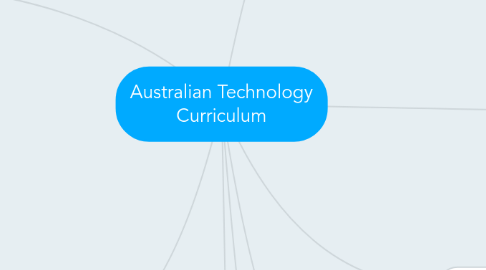
1. Subjects/Strands
1.1. DESIGN AND TECHNOLOGY: Design and technologies allows students to use their knowledge of digital thinks and technologies to create and apply solutions for needs and opportunities.
1.1.1. KNOWLEDGE AND UNDERSTANDING
1.1.1.1. The impact, use and development of technologies in everyday life.
1.1.1.2. Students can design and create concepts across a range of technology concepts.
1.1.2. PROCESSES AND PRODUCTION
1.1.2.1. Analyse and investigate needs or opportunities
1.1.2.2. Generate and develop design ideas for solutions.
1.1.2.3. Plan, produce and evaluate designs
1.2. DIGITAL TECHNOLOGY: In digital Technologies students use computational information and thinking to create, define and apply digital solutions.
1.2.1. KNOWLEDGE AND UNDERSTANDING
1.2.1.1. How data can be represented and structured using symbols.
1.2.1.2. Components of digital systems and software
1.2.1.3. The impact, use and development of digital information systems on everyday life.
1.2.2. PROCESSES AND PRODUCTION
1.2.2.1. Know how to collect, manage and interpret data when obtaining information and understand the nature and properties of data.
1.2.2.2. using different types and ranges of digital systems and the component and peripherals of different digital systems.
1.2.2.3. able to define a problem and specifically implementing solutions.
1.2.2.4. communicating information online and understanding and interacting safely, whilst respecting technical and social protocol.
2. GENERAL CAPABILITIES
2.1. Literacy
2.2. Numeracy
2.3. ICT Capability
2.4. Critical and creative thinking
2.5. Personal and social capbility
2.6. Ethical understanding
2.7. Intercultural understanding
3. ACHIEVEMENT STANDARDS
3.1. FOUNDATION TO YEAR 2: students describe the purpose of familiar products, services and environments and how they meet the needs of consumers and the affect on others and environments. They identify the features and uses of some technologies for each of the prescribed technologies contexts.
3.2. YEAR 3 TO 4: students explain how products, services and environments are designed for communities and their environments to meet needs. They describe contributions of people in design and technologies occupations. Students describe how the features of technologies can be used to produce designed solutions for each of the prescribed technologies contexts.
3.3. YEAR 5 TO 6: students describe some different considerations in the design of products, services and environments taking into account sustainability. They describe how design and technologies contribute to meeting present and future needs. Students explain how the features of technologies impact on designed solutions for each of the prescribed technologies contexts.
4. AIMS AND OBJECTIVES
4.1. Allow students to be innovative, creative and enterprising when using technologies and having an understanding of how technology has been developed.
4.2. Select and use appropriate tools, programs, systems, data etc when designing and creating in digital environments.
4.3. Analyse technologies to create solutions for a range of problems or opportunities.
4.4. Be confident when using technologies.
5. STUDENT DIVERSITY
5.1. Students with disabilities
5.2. English as a second language or dialect
5.3. Gifted or Talented Students
6. CROSS CURRICULUM PRORITIES
6.1. Sustaninability
6.2. Aboriginal and Torres Strait Islander history and cultures
6.3. Asia and Australia’s engagement with Asia
7. BANDS
7.1. DESIGN AND TECHNOLOGY
7.1.1. FOUNDATION TO YEAR TWO: Students investigate and play with the technologies and materials to find out their purpose and how they meet social needs. The begin to understand how society and sustainability influence design and technological decisions. With support of teachers, they plan simple steps and directions to complete design ideas or projects.
7.1.2. YEAR 3 TO 4: There is a focus on the development of self and ownership of original ideas and thinking in relation to their peer and wider communities. Exploration of creative and innovative ideas and alternatives and apply their own design skills. Students use their creative and imaginative skills to design products, services and environments through planning and careful selection of materials, tools and equipment. They reflect on their design and refine and develop.
7.1.3. YEAR 5 TO 6: Critical examination of technologies, materials, systems, tools and equipment used in everyday life, with underlying consideration of society, ethics and sustainability. Students will consider why and for who technologies are developed.
7.2. DIGITAL TECHNOLOGY
7.2.1. FOUNDATION TO YEAR 2: Students begin to think computationally when using digital systems they play with. Eg: robotic toys. Development of problem solving skills through abstraction and management of time, tasks and data when using digital systems to create information. Through support they begin to understand steps and the sequence of steps for their robots or achieve goals through abstract thinking of elements (including within systems) to solve problems.
7.2.2. YEAR 3 TO 4: Students think computationally by using digital systems to simplify and automate simple tasks and data processing. Explorations begins into abstractions by interpreting simple real world systems and describing elements of problems. Different ways of common data can be represented. Expand usage of software through using a range of types (including visual programming languages).
7.2.3. YEAR 5 TO 6: students think computationally by using digital systems to simplify and automate tasks and analyse data, which are organised in a manner that helps computation. Development of abstractions by identifying common elements across similar problems and systems. Begin to show understanding of the relationship between models and the real-world systems they represent. Further problem solving development through following instructions and decision making to detect errors and modifying errors to create working digital solutions. They broaden their techniques for recording algorithms to include text-based instructions. They increase the sophistication of their abstract thinking by identifying repetition and develop their skills by incorporating repeat instructions/structures including through visual programming.

